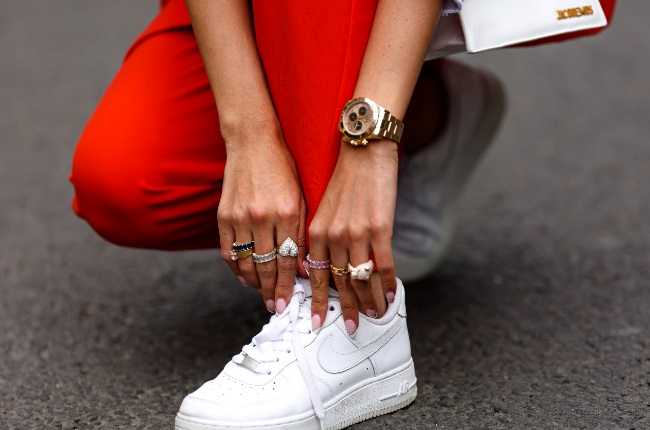
- Sneakers (or trainers if you’re British), once the symbol of athleticism, have transcended their primary function to become commercial and fashionable objects of desire.
- From sportswear and street style to catwalk fashion, sneakers have made their mark as cultural commodities.
- The global sneaker market valued at approximately US $79 billion in 2020 and is predicted to reach US$120 billion by 2026. With such huge growth, it is unsurprising that they are considered big business.
Such are the strides in the sneaker industry that a new exhibition at London’s Design Museum explores how the shoe became an undisputed cultural symbol of our times.
Comfort is king
The last decade has seen a huge shift in how sneakers are worn. Donning a pair is no longer frowned upon in the workplace or on more formal occasions. Even British etiquette experts Debrett’s have given their seal of approval, deeming them socially acceptable for smart casual occasions.
The continued dominance of the athleisure trend has had a significant impact on the growing sales of sneakers – along with the pursuit of comfort. This only grew more during the pandemic as lockdowns made people further prioritise comfort, which resulted in a rise in sales of loungewear, athleisure and flat shoes, like sneakers.
READ MORE: Shoes inspired by the '70s that you'll want to add to your 2021 collection immediately
As such, sneakers have moved from the niche to become coveted as fashionable objects. Footwear is now the biggest selling category in the online luxury market and sneakers have made a significant contribution to this growth.
High fashion brands from Gucci to Balenciaga are setting the pace in the luxury sneaker market. In 2017, Balenciaga’s Triple S became the biggest seller in the luxury sneaker market and its popularity seems unstoppable.
To understand how the sneaker has emerged to become a footwear phenomenon, it is important to trace its legacy from function to cultural icon.
From tennis shoes to track
The earliest sports shoes were created by The Liverpool Rubber Company, founded by John Boyd Dunlop, in the 1830s. Dunlop was an innovator who discovered how to bond canvas uppers to rubber soles. These were known as sandshoes and worn by Victorians on their beach excursions.
Historian Thomas Turner defines the latter decades of the 19th century as a time when industrial progress and social change were twinned with a growing enthusiasm for sporting pursuits, in particular lawn tennis. This resulted in the need for a more specialised type of footwear, which Dunlop’s rubber sole could fulfil. Dunlop launched their now iconic, Green Flash model in 1929, which was worn by tennis legend Fred Perry at Wimbledon.
Other significant sports shoes of the 20th century included the Converse All Star, designed for basketball. However, it is Adidas and Nike that have both shaped the sneaker’s evolution from sport to style.
(Photo by Edward Berthelot/Getty Images)
(Photo by Vanni Bassetti/Getty Images)
Founded by Adi Dassler in Germany in 1924 as “Gebrüder Dassler Schuhfabrik”, the company later rebranded as Adidas in 1949. The brand created the first track shoe with a complete leather sole and hand-forged spikes, which was worn by Jessie Owens at the 1936 Berlin Olympics.
READ MORE: These 5 white sneaker cleaning myths are actually ruining your precious shoes
Nike was created by Bill Bowerman and Phil Knight in 1964 as Blue Ribbon Sports and became Nike Inc. in 1971. This coincided with the running craze that hit America. Nike’s first commercial design was the Cortez, cushioned for running. The Cortez was worn by Tom Hanks in Forrest Gump, securing Nike’s cultural status.
The commercialisation of cool
Research by the sociologist Yuniya Kawamura on sneakers defines three waves of the phenomenon. The first wave in the 1970s was defined by an underground sneaker culture and the emergence of hip-hop. Adidas’ Samba design, as a key example, became a key part of Terrace Fashion within football fan subculture. In 1986, Run-DMC released the song My Adidas, leading to a sponsorship deal with the brand. This forged the sneaker’s deep-rooted place in popular culture.
The second wave of the phenomenon began in 1984 with the launch of Nike Air Jordans. This gave rise to the commodification of sneakers and their desirability as status items, fuelled through celebrity endorsements. For Kawamura the third wave is marked by the digital age and the resulting growth in sneaker marketing and resell culture.
The global sneaker resale market was valued at US$6 billion (£4.6 billion) in 2019 and is forecast to be worth US$30 billion (£21 billion) by 2030.
The growing presence of “sneakerheads” who collect and trade sneakers have ensured that they maintain cult status. Nike and Adidas routinely release limited editions shoes associated with a celebrity, hip-hop star or athlete.
It is not unusual for people to go to extreme lengths to get their hands on these rare models, queuing through the night. Examples include Nike Air Yeezy 2 “Red October”, and Air Jordan x 1 Off-White “Chicago”.
These shoes have a retail value of US$190 to US$240 (£135 to £170) and are reselling for between US$1,695 and US$6,118 (£1,202 and £4,339). The lucrative sneaker resale market has created a new cult of sneaker enthusiasts who through entrepreneurial spirit are generating significant hype along with personal income.
From sport to fashion, sneakers dominate the consumer market. Yet, despite their adoption by the mainstream, sneakers retain their coolness as cultural icons.
This article is republished from The Conversation under a Creative Commons license. Read the original article.
Follow us on social media: Facebook, Twitter, Instagram
Sign up to W24's newsletters so you don't miss out on any of our stories and giveaways.




 Publications
Publications
 Partners
Partners













